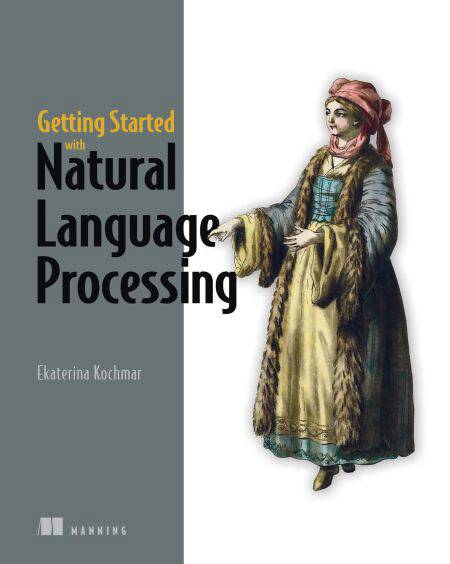
- Retrait gratuit dans votre magasin Club
- 7.000.000 titres dans notre catalogue
- Payer en toute sécurité
- Toujours un magasin près de chez vous
- Retrait gratuit dans votre magasin Club
- 7.000.0000 titres dans notre catalogue
- Payer en toute sécurité
- Toujours un magasin près de chez vous
41,37 €
+ 41 points
Format
Description
Hit the ground running with this in-depth introduction to the NLP skills and techniques that allow your computers to speak human.
In Getting Started with Natural Language Processing you’ll learn about:
Fundamental concepts and algorithms of NLP
Useful Python libraries for NLP
Building a search algorithm
Extracting information from raw text
Predicting sentiment of an input text
Author profiling
Topic labeling
Named entity recognition
Getting Started with Natural Language Processing is an enjoyable and understandable guide that helps you engineer your first NLP algorithms. Your tutor is Dr. Ekaterina Kochmar, lecturer at the University of Bath, who has helped thousands of students take their first steps with NLP. Full of Python code and hands-on projects, each chapter provides a concrete example with practical techniques that you can put into practice right away. If you’re a beginner to NLP and want to upgrade your applications with functions and features like information extraction, user profiling, and automatic topic labeling, this is the book for you.
About the technology
From smart speakers to customer service chatbots, apps that understand text and speech are everywhere. Natural language processing, or NLP, is the key to this powerful form of human/computer interaction. And a new generation of tools and techniques make it easier than ever to get started with NLP!
About the book
Getting Started with Natural Language Processing teaches you how to upgrade user-facing applications with text and speech-based features. From the accessible explanations and hands-on examples in this book you’ll learn how to apply NLP to sentiment analysis, user profiling, and much more. As you go, each new project builds on what you’ve previously learned, introducing new concepts and skills. Handy diagrams and intuitive Python code samples make it easy to get started—even if you have no background in machine learning!
What's inside
Fundamental concepts and algorithms of NLP
Extracting information from raw text
Useful Python libraries
Topic labeling
Building a search algorithm
About the reader
You’ll need basic Python skills. No experience with NLP required.
About the author
Ekaterina Kochmar is a lecturer at the Department of Computer Science of the University of Bath, where she is part of the AI research group.
Table of Contents
1 Introduction
2 Your first NLP example
3 Introduction to information search
4 Information extraction
5 Author profiling as a machine-learning task
6 Linguistic feature engineering for author profiling
7 Your first sentiment analyzer using sentiment lexicons
8 Sentiment analysis with a data-driven approach
9 Topic analysis
10 Topic modeling
11 Named-entity recognition
In Getting Started with Natural Language Processing you’ll learn about:
Fundamental concepts and algorithms of NLP
Useful Python libraries for NLP
Building a search algorithm
Extracting information from raw text
Predicting sentiment of an input text
Author profiling
Topic labeling
Named entity recognition
Getting Started with Natural Language Processing is an enjoyable and understandable guide that helps you engineer your first NLP algorithms. Your tutor is Dr. Ekaterina Kochmar, lecturer at the University of Bath, who has helped thousands of students take their first steps with NLP. Full of Python code and hands-on projects, each chapter provides a concrete example with practical techniques that you can put into practice right away. If you’re a beginner to NLP and want to upgrade your applications with functions and features like information extraction, user profiling, and automatic topic labeling, this is the book for you.
About the technology
From smart speakers to customer service chatbots, apps that understand text and speech are everywhere. Natural language processing, or NLP, is the key to this powerful form of human/computer interaction. And a new generation of tools and techniques make it easier than ever to get started with NLP!
About the book
Getting Started with Natural Language Processing teaches you how to upgrade user-facing applications with text and speech-based features. From the accessible explanations and hands-on examples in this book you’ll learn how to apply NLP to sentiment analysis, user profiling, and much more. As you go, each new project builds on what you’ve previously learned, introducing new concepts and skills. Handy diagrams and intuitive Python code samples make it easy to get started—even if you have no background in machine learning!
What's inside
Fundamental concepts and algorithms of NLP
Extracting information from raw text
Useful Python libraries
Topic labeling
Building a search algorithm
About the reader
You’ll need basic Python skills. No experience with NLP required.
About the author
Ekaterina Kochmar is a lecturer at the Department of Computer Science of the University of Bath, where she is part of the AI research group.
Table of Contents
1 Introduction
2 Your first NLP example
3 Introduction to information search
4 Information extraction
5 Author profiling as a machine-learning task
6 Linguistic feature engineering for author profiling
7 Your first sentiment analyzer using sentiment lexicons
8 Sentiment analysis with a data-driven approach
9 Topic analysis
10 Topic modeling
11 Named-entity recognition
Spécifications
Parties prenantes
- Auteur(s) :
- Editeur:
Contenu
- Nombre de pages :
- 456
- Langue:
- Anglais
Caractéristiques
- EAN:
- 9781638350927
- Date de parution :
- 14-11-22
- Format:
- Ebook
- Protection digitale:
- Adobe DRM
- Format numérique:
- ePub

Les avis
Nous publions uniquement les avis qui respectent les conditions requises. Consultez nos conditions pour les avis.






